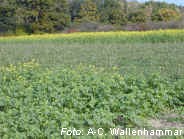Quality bread grain

High protein content through combination of preceeding crop and fertiliser
Project coordinator: Ann-Charlotte Wallenhammar, The Rural Economy and Agricultural Societies,
Organically grown quality wheat is in short supply on the market and meeting the demands of flour millers is very difficult at the present time. A common strategy in organic wheat growing is to take the benefit of nitrogen-fixing preceeding crops. However, after break-up of leys or other soil tillage, the risk of nitrogen losses is great. The picture shows white mustard as a catch crop
In a five-year project, the after-effects of a clover/grass ley were investigated at different times and combined with sowing of a catch crop. The highest yields and protein contents were obtained when the ley was ploughed under at the beginning of August. However, the technique for establishing the catch crop can be improved and herein lies potential.
Supplying nitrogen in the form of different organic fertilisers before sowing and in the growing crop is another potential method to improve nitrogen availability to the wheat, since cumulative experience has shown considerable differences in nitrogen mineralisation rates between different products and types of animal manure.
A third option is to use different soil tillage measures during the growing season to stimulate soil processes in general and nitrogen mineralisation in particular. Research has shown e.g. that row hoeing promotes protein storage. However, different wheat cultivars react differently. In this project, we are combining different nitrogen supply strategies in different ways and investigating the effects on yield and protein content of both spring and winter wheat.
The following sub-projects are included:
- Spring wheat. High protein content through N-rich pre-crop and catch crop combined with medium-late acting supplement of organic fertiliser. Field trial with and without catch crop after ley break-up where beef cattle manure and Bio Vinass are added at various times. The manure types represent cropping systems with and without animals resp. at comparable levels. Three trials (R7-340) were established in 2002. For the 2002 harvest, only the effects of organic fertiliser were investigated.
- Winter wheat. High protein content through N-rich pre-crop combined with measures to stimulate nitrogen mineralisation during spring/summer. Field trial where the effects of different weed control soil tillage systems (tine harrowing, weed harrowing and row hoeing) are compared with untilled, with and without addition of cattle slurry. Three trials (R7-145) were established in 2002.
- Winter wheat/spring wheat. High protein content through N-rich pre-crop combined with measures to stimulate nitrogen mineralisation during spring/summer. Cultivar comparison. Field trial where the effects of different weed control soil tillage systems (tine cultivator, weed harrow and row hoe) are compared with untilled. Different winter wheat and spring cultivars are being compared. Test baking and sensory analysis is being carried out in selected treatments. Four trials in spring wheat (R7-341) were carried out in 2002 and four in winter wheat (R7-146) were established in 2002.
- Research on soil tillage and spring wheat cultivars in organic cropping (See below). Project leaders:Gunnar Svensson1, Hans Larsson1 and Lars Erik Anderson2, 1Department of Crop Science, SLU, Alnarp, 2 The Rural Economy and Agricultural Societies, Örebro.
Contact: Gunnar Svensson
Preliminary experiments have shown that greater row spacing and restricted seed rate combined with row hoeing produce considerably higher protein content in wheat with an acceptable reduction in yield. However, different cultivars react differently. In experiments in 2002 at four different sites/regions, spring wheat at various row spacings was investigated with one to three harrowings to 12 cm and two row hoeings at 24 or 36 cm row spacing. The cultivars Dragon, Svenno and Ölänskt wheat were included. Weed competition, straw and grain yield and quality were evaluated.